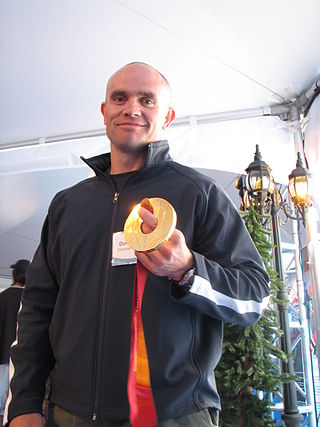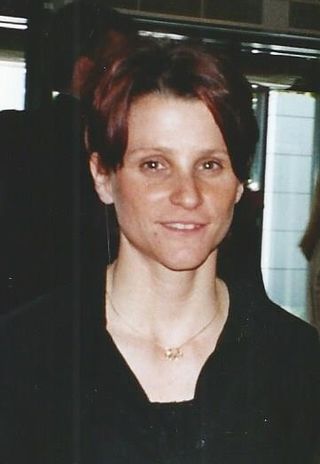
James Edmound Shea Jr. is an American skeleton racer who won the gold medal at the 2002 Winter Olympics in Salt Lake City.

Duff Gibson is a Canadian skeleton racer who competed from 1999 to 2006. He was born in Vaughan, Ontario. His father was born on December 13, 1937. At the 2006 Winter Olympics in Turin, He won the gold medal in the men's skeleton, narrowly beating out his teammate Jeff Pain. With his victory, the 39-year-old Gibson surpassed ice hockey player Al MacInnis as the oldest gold medalist in Canadian Winter Olympic history. More significantly, Gibson became the oldest individual gold medallist in the history of the Winter Games, a record previously held by Norway's Magnar Solberg, who was 35 when he won the gold medal in the 20 km individual biathlon event at the 1972 Winter Olympics in Sapporo; he held the record until Ole Einar Bjørndalen won gold at the 10 km biathlon sprint aged 40 at the 2014 Sochi Olympics. He retired immediately following the 2006 Games in Turin.
Frank Kleber is a German skeleton racer who has competed since 2000. He won two medals at the FIBT World Championships with a gold in 2007 and a bronze in 2004.

Gregor Stähli is a Swiss skeleton racer who has competed since 1989. He won two bronze Winter Olympic medals in the men's skeleton, earning them in 2002 and 2006.

Jeffrey Thomas "Jeff" Pain is an American-born Canadian former skeleton racer who competed from 1995 to 2010. He is regarded as one of the most successful male competitors in the history of the Canadian skeleton program. He was born in Anchorage, Alaska.
Martin Rettl is an Austrian skeleton racer who competed from 1989 to 2006. Competing in two Winter Olympics, he won a silver medal in the men's skeleton event at Salt Lake City in 2002.

Maya Pedersen-Bieri is a Swiss-Norwegian skeleton racer who has competed since 1995. She won the gold medal in the women's skeleton event at the 2006 Winter Olympics in Turin. She retired from the sport in 2010 before returning to compete for Norway in 2016, becoming at the oldest woman to start a World Cup race when she returned to the top level of skeleton in 2017. She is listed in the International Bobsleigh and Skeleton Federation athlete registration system as Maya Pedersen.
Siobhán Hoey is an Irish sportswoman from Portarlington, County Laois. She has competed in both track and field and bobsleigh.

Mellisa Hollingsworth is a retired Canadian athlete who competed from 1995 to 2014. She won the bronze medal in the women's skeleton event at the 2006 Winter Olympics in Turin.
Gerda Weissensteiner OMRI is an Italian luger and bobsleigh pilot who competed from the late 1980s to 2006. Competing in six Winter Olympics, she won the gold medal in the women's singles luge event at the 1994 Winter Olympics in Lillehammer, and together with Jennifer Isacco she won the bronze in Turin in the two-woman bobsleigh at the 2006 Winter Olympics. She was the first Italian sportsperson to win Olympic medals in two disciplines.

Noelle Pikus-Pace is an American retired skeleton racer who began her career in 2001. She won five medals at the FIBT World Championships, competed in the 2010 Winter Olympics in Vancouver, and won the silver medal in the 2014 Winter Olympics in Sochi.

Susi-Lisa Erdmann is an East German-German luger and bobsledder who competed from 1977 to 1998 in luge, then since 1999 in bobsleigh. She was born in Blankenburg, Bezirk Magdeburg. Competing in five Winter Olympics, she won two medals in the women's singles luge event with a silver in 1994 and a bronze in 1992, and a bronze at the inaugural two-women bobsleigh event in 2002. She is one of only two people to ever win a medal in both bobsleigh and luge at the Winter Olympics; Italy's Gerda Weissensteiner is the other.

Brian Shimer is an American bobsledder who competed from 1985 to 2002. Competing in five Winter Olympics, he won the bronze medal in the four-man event at Salt Lake City in 2002.
Ryan Davenport is a Canadian skeleton racer who competed from 1993 to 1999. He won three medals in the men's skeleton event at the FIBT World Championships with two golds and one bronze (1995).
Michelle Kelly is a Canadian former skeleton racer who competed from 1994 to 2013. A two-time Olympian, Kelly is largely considered to be one of the pioneers of the sport of Women's Skeleton. Originally an elite gymnast, she was recruited for her explosive power to the Canadian Women's National Bobsleigh Team as a brakeman, competing from 1994 to 1999. In 1995 Kelly started sliding Skeleton and competing in both sports. When Women's Skeleton and Bobsled were both named to make their debut at the 2002 Winter Olympics in Salt Lake City, Kelly chose Skeleton. She finished 10th at those 2002 Games, and went on to earn the Olympic alternate position at the 2006 Torino Olympics, and another Olympic birth at the 2010 Winter Olympics, finishing 13th. Kelly won a complete set of medals at the FIBT World Championships with a gold in 2003, a silver in 2008, and a bronze in 2005, as well as taking the women's Skeleton World Cup overall title in 2002-3.
Lindsay Alcock is a Canadian skeleton racer who has competed since 1998. She won a silver medal in the women's skeleton event at the 2004 FIBT World Championships in Königssee.

Kerstin Szymkowiak is a German retired skeleton racer who has competed since 2002. She won three bronze medals in the women's skeleton event, earning them in 2004, 2008, and 2009.

Katie Uhlaender is an American skeleton racer who has competed since 2003. She has won six medals at the FIBT World Championships with two gold, one silver, and three bronze.
Lea Ann Parsley is a retired American skeleton racer from Granville, Ohio. She was the first female skeleton athlete to win a world cup medal for the United States and earned a silver medal in the women's skeleton event, a first in Olympic history, during the 2002 Salt Lake City Olympic Winter Games. She was also one of eight athletes chosen to carry the World Trade Center flag into the Opening Ceremony of the 2002 Winter Olympics.
For the 1948 Winter Olympics in St. Moritz, Switzerland, a total of eight sports venues were used. The five venues used for the 1928 Winter Olympics were reused for these games. Three new venues were added for alpine skiing which had been added to the Winter Olympics program twelve years earlier in Garmisch-Partenkirchen, Germany. As of 2015, the bob run continues to be used for bobsleigh and the Cresta Run for skeleton while alpine skiing remains popular in St. Moritz.












